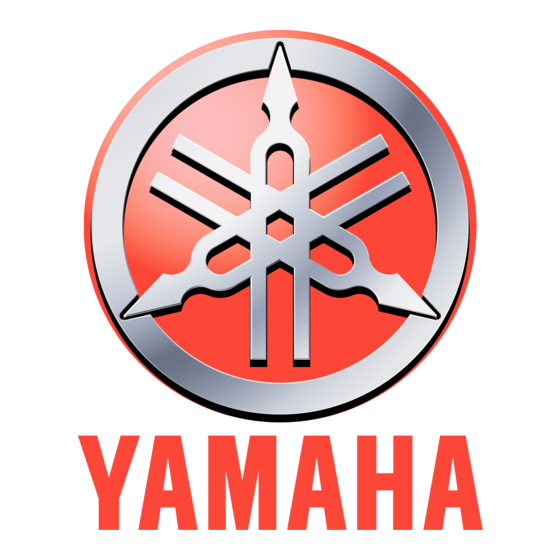
Summarization of Contents
Important Manual Information
To the Owner
Provides essential information for proper operation, maintenance, and care of the Yamaha outboard motor.
General Information
Identification Numbers Record
Details on recording outboard motor serial number and key number for reference and spare parts.
Emission Control Information
Explains conformance to EPA regulations and shows approval label location.
Safety Information
Crucial safety precautions before mounting or operating the outboard motor.
Basic Boating Rules
Essential rules for navigating waterways and interacting with other vessels.
Fueling Instructions
Gasoline and Oil Recommendations
Guidelines on using unleaded gasoline, octane ratings, gasohol, and recommended engine oil.
Propeller Selection
Propeller Selection and Start-in-Gear Protection
Explains propeller choice effects and start-in-gear safety feature.
Basic Components
Main Components Identification
Identifies key parts of the outboard motor with diagrams and labels.
Remote Control System
Covers the remote control box, lever, and associated switches for operation.
Control Levers and Triggers
Details remote control lever, neutral interlock trigger, and throttle levers.
Throttle Controls
Explains neutral throttle lever, free accelerator, and throttle friction adjuster.
Engine Stop Lanyard Switch
Explains the safety switch and lanyard for stopping the engine.
Main Switch and Power Trim/Tilt
Details operation of the main switch and power trim/tilt switches.
Trim Tab and Anode
Covers trim tab adjustment for steering and its anode function.
Motor Support and Flushing
Details tilt support lever, cowling locks, and flushing device.
Gauges and Indicators
Tachometer and Trim Meter
Describes engine speed and trim angle gauges.
Warning Indicators
Alerts operator to issues like overheating, low oil, or low battery.
Speedometer and Fuel Gauge
Displays boat speed and indicates fuel level.
Hour Meter and Trim Meter (Digital)
Tracks engine operating hours and displays trim angle digitally.
Trip Meter and Clock
Displays distance traveled and allows setting the clock.
Fuel Management System
Covers fuel warning indicator and fuel management meter functions.
Fuel Flow and Consumption Meters
Displays fuel flow rate and total fuel consumed.
Fuel Economy and Speed Synchronization
Shows fuel efficiency and engine speed difference for twin engines.
Warning System
Overheat Warning
Alerts to high engine temperature, reducing speed and sounding a buzzer.
Oil Level and Filter Warnings
Warns about low oil level or clogged filter, reducing engine speed.
Operation
Installation and Mounting
Instructions and cautions for properly mounting the outboard motor and setting mounting height.
Engine Break-in and Preoperation Checks
Procedure for initial engine break-in and essential checks before operation.
Shifting
Instructions for shifting between forward, neutral, and reverse gears.
Stopping Engine
Procedure for safely stopping the engine after operation.
Trimming Outboard Motor
Explains how trim angle affects boat performance and handling.
Tilting Up and Down
Procedures for tilting the motor for protection or shallow water operation.
Cruising in Shallow Water
Guidelines for operating the outboard motor in shallow water conditions.
Maintenance
Specifications
Provides detailed technical specifications for the outboard motor models.
Maintenance Chart
Outlines recommended maintenance intervals and tasks for various components.
Battery Care and Flushing
Essential guidelines for battery maintenance and flushing the cooling system.
Fuel System Maintenance
Steps for inspecting and cleaning the fuel filter and system.
Propeller and Gear Oil
Procedures for propeller maintenance and changing gear oil.
Anodes and Battery
Guides on inspecting anodes and checking battery condition.
Trouble Recovery
Troubleshooting Guide
Lists common problems and their possible solutions for starting and operation.
Engine Performance Issues
Addresses engine power loss, excessive vibration, and stalling.
Emergency Procedures
Steps for impact damage, running single engine, and emergency starting.
System Checks and Replacements
Covers fuse replacement, trim/tilt system, and starter issues.
Impact Damage Emergency Actions
Immediate steps to take in case of impact damage to the motor.
Replacing Fuse and Trim/Tilt Issues
Covers fuse replacement and troubleshooting trim/tilt system failures.
Manual Start and Starter Issues
Procedures for manual starting and troubleshooting starter mechanism failures.
Engine Fails to Operate
Addresses issues when the engine fails to operate, including low oil warnings.
Submerged Motor Treatment
Steps to minimize damage if the outboard motor is submerged.
Consumer Information
Warranty Information (U.S.A. & Canada)
Explains warranty coverage, registration, and repair procedures for U.S.A. and Canada.
Warranty Exclusions and Q&A
Details parts excluded from warranty and answers common customer questions.
Customer Service and Address Change
Provides contact details and instructions for updating customer information.
International Warranty Information
Clarifies warranty applicability for Yamaha products used internationally.





Need help?
Do you have a question about the Z175 and is the answer not in the manual?
Questions and answers